Behold the Gray Panthers
Back to Contents of Issue: November 2003
|
|
|
|
by Darrel Whitten |
|
|
The bad news is that the IMF estimates that Japan's GDP will fall by 20 percent over the next century. The good news is that projections have seniors spending nearly JPY11 trillion a year.
But developing this market based on a "nursing home" mindset has turned out to be an uphill slog. Mass production of products for the elderly is difficult because their needs are diverse, so few large companies have entered the field. (Small and medium-sized businesses currently provide the bulk of services for the elderly.) In addition, prices cannot be lowered to affordable levels since trimming the costs for such specific products and services is nearly impossible. And because of the high costs relative to disposable income, the industry is protected by a subsidy system, which inhibits technical and business innovation.
The Nomura Research Institute calls the elderly industry a "social asset industry." While social needs are high, these segments cannot commercially stand alone due to low individual-product demand. Nomura also calls them "disk-shaped industries" because needs are diverse and the market is wide, yet the demand for each individual item is low and the market is shallow.
What the reports by Nomura and many others miss is that there are actually three distinct categories of seniors: what Dentsu calls "hyper-seniors," "seniors" (mid 50s to late 60s), and "the elderly" (those over 75). Hyper-seniors are the segment's trendsetters. They are active consumers and have a high capacity for absorbing information. In Dentsu's survey group, hyper-seniors account for about 30 percent of the total.
The most economically adverse demographic changes will occur from 2025 to 2075, when the real increase of the elderly starts to kick in. Until then, the proportion of Japan's population referred to as "seniors" will expand rapidly. According to 2002 population statistics, Japan's senior population (those ages 56 to 69) was 22 million. According to a Dentsu study in 2000, the number of healthy senior spenders (the estimated seniors population less the number expected to require health care) was 18.5 million; that number is expected to be 25 million by 2010. In 2000, seniors accounted for 50.4 percent of total consumption, and this is expected to rise to 51.7 percent by 2005, and up to 52.0 percent by 2010.
Consumption-related businesses can no longer afford to ignore the seniors market. But as opposed to the younger generation, which is much more susceptible to what's "in," seniors have well-established tastes and a sense of value, particularly regarding travel, health and money. They are not easily influenced by mass advertising. Instead, Japanese seniors are much more loyal to their own communities, while they also look for new acquaintances, friends and experiences.
Japan's seniors are the ones who have all of the financial assets, and in a deflationary environment, the larger the cushion of financial assets, the larger real purchasing power and the higher the propensity to consume. Tokyo Shoko Research began a new service in June of this year that offers strategic support to the retail and service industries in developing the seniors market. As of 2002, net savings of those over 60 averaged JPY24.12 million per Japanese household, while 66.8 percent of all households in this age bracket had savings of over JPY10 million. In comparison, those in their 50s had average savings of JPY11.33 million per household, while households in their 30s and 40s had net savings of a mere JPY1.19 million to JPY2.63 million.
Moreover, if the Japanese equity market has in fact bottomed out and is entering a long-term recovery phase as some claim, the biggest immediate beneficiaries of a recovery in capital market values will be Japan's seniors. Average monthly expenditures for this group are already the highest of any age group. For example, average monthly consumption expenditures for those in their 30s is JPY257,387; for those in their 60s, it is JPY258,515; but for those in their 50s, it is JPY319,501.
It's the seniors who have all the money and are now beginning to lead Japanese consumption. Their propensity to spend their disposable income (after-tax income) gives a clear indication of this. According to data compiled by the Dai-Ichi Life Research Institute, the index of propensity to consume for seniors over 60 years of age has increased from 100 in the first quarter of 2002 to 120 by the first quarter of 2003. Conversely, the under 29 crowd, long the freest spenders by age group and the target of most print and electronic media advertising, went from 100 to 120 by the third quarter of 2002 but then slipped to just over 96. Those age 30 to 39 and 40 to 49 have ranged between 100 to 102 during the same period. According to the household survey, it is the prime wage-earner households consisting of more than two people that have taken the brunt of the impact of the "Heisei malaise," where monthly wages have fallen by 9.7 percent since 1997.
Here is a brief summary of the myths and the reality regarding Japan's seniors market:
Myth: Seniors prefer to socialize in the non-metropolitan areas, congregate at seniors clubs and play gateball.
The "sweet era" of Gray Panther consumption is likely to be from now until 2010, because they represent the core of Japan's original postwar baby boom. As Japan's population continues to age rapidly, the majority of Japan's baby boom seniors will begin shifting towards the 70-and-older group after 2010. There will likely be a second Gray Panther movement from the second baby boom generation, which is now in its mid-30s to mid-40s. However, this group was not as fortunate as their parents in terms of affordable housing purchases. Moreover, the government will be taking a big bite out of the property and financial assets they inherit from their parents in the form of inheritance taxes.
Within each loan program, the amounts you can get generally depend on your age and your home's value: The older you are, the more cash you can get. The more your home is worth, the more cash you can get. When the loan is over, you or your heirs must repay all of your cash advances plus interest.
Reputable lenders don't want your house; they want repayment. All reverse mortgages are due and payable when the last surviving borrower dies, sells the home or permanently moves out of the home. In the US, one type of reverse mortgage, a home equity conversion mortgage, is insured by the federal government.
Japanese seniors live in relatively larger dwellings than younger households. The average area of dwellings inhabited by older persons is 80 square meters for single-person households, 108 square meters for elderly couples and 123 square meters for multiple-generation households. That means they pay relatively higher property taxes and maintenance costs on basically similar levels of income.
Their asset value to disposable incomes is 3.6 times that of their US counterparts. The ratio of value of assets to disposable income is much higher among older Japanese than it is with their US counterparts (24 times against 6.6 times). While the spending of older Japanese exceeds their disposable income by 4.5 percent, on paper at least, they could keep this up for 20 years and would still retain assets worth 23 times their annual disposable income.
For households of at least two persons with the householder age 60 or over, the average value of family assets per household is JPY65.6 million, of which land assets accounted for JPY38.0 million, or 58 percent of total net assets. Yes, households headed by the 60-plus crowd have 4.4 times the financial assets of households headed by those under 60. But not all elderly households in Japan have net assets worth JPY60 million. Indeed, 63 percent of all households surveyed fall below the average net asset value. The largest group (just over 12 percent of the total) falls into a range of "more than JPY20 million but less than JPY30 million" of net worth.
With a pension system in serious trouble, rising health costs and "stealth" tax increases, the last thing Japan's seniors are thinking about is making "risky" investments or rapid draw-downs in their savings, particularly as they get older. Going forward, the burden of social security provisions like pensions, medical care and welfare can only increase.
Consequently, the introduction of reverse mortgages could give some seniors a way to convert their unrealized fixed asset values into spendable cash.
• Taking tours customized for their own groups
Fashionable clothes
Kanebo and Onward Kashiyama are now designing more fashionable, "young-oriented" clothing for middle-aged and older Japanese women. Onward Kashiyama has developed a brand called "Jane Moore" specifically for women in their late 50s and 60s, and has begun moving away from the old, dull "Mrs" clothes. Sales of the Jane Moore brand in the year to February 2000 were JPY8.5 billion; they jumped to JPY10.5 billion in the year to February 2003.
Riding the tide of increasing sports club membership by seniors, Wacoal has come out with the "Grappi" undergarment brand that is growing at an unprecedented rate. In a segment where it more commonly takes 10 years to reach JPY1 billion in annual revenues, this brand had already exceeded that level in the first year of marketing through March 2000. Total sales of the brand last year were JPY2 billion, and revenues continue growing by 50 to 60 percent per annum.
From the age of 60 onward, the female shape begins to lose its shape. The Grappi undergarments help to maintain shape without being too restrictive. The brassiere itself costs about JPY6,000, or about JPY1,000 more than those for younger women. The data shows that married Japanese women between 55 and 64 spend approximately JPY57,771 per year on undergarments, or 70 percent more than married women age 20 to 34; 60 percent more than women age 35 to 44; and essentially the same amount as unmarried women age 20 to 34.
One couple lives in Kanagawa, the other in Chuo Ward. They both really like the cooking at Hotel Okura's Terrace Restaurant, but they never eat there. One couple orders their meal and takes it home; the other couple has the restaurant deliver it to them. One couple orders such meals three times a week; the other couple orders once a week. Each order can easily exceed JPY10,000. But both couples say that's still a bargain when compared to the time it takes to shop and prepare a meal of similar quality. The Okura Hotel's Terrace Restaurant just began offering this service this April, while the Chinese restaurant in the hotel offers home delivery to any of Tokyo's 23 wards. Skylark restaurants began offering a similar, albeit more budget-oriented, take-home order service in June 1998. In fiscal 2002, orders for this service produced JPY15.6 billion in revenues, or 5.4 percent of Skylark's total revenues.
MiniMaid Services and Duskin have always offered house/office cleaning services. They used to contract with individuals to have three female staff come one to four times a month for house cleaning. From October of last year, they began offering a new service for customers whose average age is 62. Whereas a monthly contract with several people visiting the house several times a month would run JPY16,000 to JPY25,000 per trip, the new service needs only one cleaner and offers a menu of 150, 210 and 270 minutes to perform specific cleaning tasks; it costs a more reasonable JPY9,000 to JPY14,000 per trip.
In May, the Socie World chain of beauty salons began an advertising campaign aimed at older women. Of the new members during the first six months of the year, the proportion of women in their 50s rose to 10.8 percent of the total, and the ratio of women in their 60s rose to 7.8 from 4.1 percent. These women are coming with their daughters, which makes it much easier for them to make the decision.
In September, the chain plans to create a pamphlet aimed at newly betrothed ladies and their mothers. The number of mothers getting primped for their daughter's wedding has been rising rapidly over the past several years, to the point that 30-40 percent of the mothers of brides-to-be are coming in to get primped. Women in their 50s and 60s are dropping JPY100,000 to JPY200,000 to have their wrinkles smoothed away.
Consumer durables
According to the top salesman in the company, some 40 percent of his clients are in their 50s and 60s, and older couples are using the occasion of the husband's retirement to reform their residences.
Last summer, Denon received an unusual complaint from a customer: Neither the housing makers nor the home electronic goods outlets had any home theater displays, and neither knew that much about them.
Where could someone go for help in creating a home theater? Denon jumped on the idea and began talking with the housing makers. Sumitomo Forestry and Higashi Nihon House responded favorably. They created the position of "installer" to help customers select their equipment and build a home theater. A Denon home theater will set consumers back JPY1-2 million.
Last June, Daihatsu introduced the "Copen." One out of four people who purchase this small-engine-displacement sports car are over 50 years of age. This is 180 degrees different than 10 years previous, when the buyers of Honda's "Beat" and Suzuki's "Capuccino" sports cars were young people. Daihatsu insists that while the Copen is a small-engine-displacement car, it nevertheless is a full-fledged sports car.
With an electrically retractable roof, it retails for JPY1.5 million. The company had originally projected monthly sales of 500 cars, but orders took off immediately after the car was put on the market -- there were 5,000 orders in the first month.
Other carmakers have also begun to focus on the seniors market, according to survey results released by JAMA. Seniors want comfort, particularly during long road trips. Consequently, they are more concerned about the car's handling and its roominess. The survey results indicate that seniors do not want to pay a premium for luxury, either. Japan's seniors don't simply use their automobiles to travel long distances, though. They also go shopping and visit friends. For those everyday needs, many would prefer compact cars that can easily handle Japan's narrow roads and parking spaces. For seniors who aren't as mobile, Japanese automakers offer "special-needs" vehicles, cars and vans that come equipped with swivel chairs and other innovations that accommodate their physical needs. Supply of these vehicles has expanded at an average annual rate of 41.9 percent between 1996 and 2000.
Toyota, for example, has begun to develop vehicles targeted specifically at this growing market. It developed the Premio, which offers easy handling, a luxurious interior and a reasonable price. Competing with the Premio is Nissan's Bluebird Silphy. Priced close to the Premio, the vehicle offers a roomy interior and seats constructed on a solid structure -- features that make long-distance driving more comfortable for seniors.
A study conducted by NTT DoCoMo shows that 41 percent of seniors aged 60 and up in the Tokyo area own mobile phones. According to the study, the average phone bill for senior mobile users is $41 a month, compared to a cross-generation average of $70. About 17 percent of Tokyo-based seniors use mobile phones to send email.
However, respondents complained that the displays of their mobile Internet data handsets were too small, making reading difficult. Complaints of "feature-itis" also surfaced in the study, as seniors said the handsets have too many functions. Sure enough, the mobile-phone companies began to introduce mobile phones with larger character displays and more streamlined, easy-to-use functions. This trend is also emerging in fixed phones and other consumer electronic equipment.
Sporting goods, sports clubs, entertainment and travel
The store established a monthly high in sales of JPY23 million in July of last year, amidst the very worst of the "gloom and doom" of Japan's economy and financial markets. The shop's main clients are people in their late 50s or older.
At the "Big Echo" karaoke club in Yurakucho, a group of 20 to 30 people gather every Wednesday. They are all in their 60s and 70s and come from as far away as Chiba, Ibaraki and Shizuoka. If each orders a drink, they get the room for free. The regulars are all members of JR East's "Jipangu Club." To join the club, men have to be 65 or older, women 60 or older. It started as a program offering discount tickets for travel by train, but JR East has recently been focusing on leveraging these "special interest" clubs. "Seniors are interested in developing new friends in their same age group who have the same interests, as it gives them an excuse to be out and about," says a JR East official. During the March 2003 fiscal year, JR East Jipangu Club members used an average of 10.5 discount train tickets per club member, producing JPY27 billion in revenue for the company. Package tours for club members gained another JPY1.7 billion. The company plans to increase the number of club members from the current 770,000 to 1 million by 2005, and to increase the number of special interest groups from 50 last year to over 100 this year.
This trend has also caught the attention of Kinki Nippon Tourist, which now has some 200 "club circles" with a total membership of about 250,000, of which more than half are over 60. These circles generate some 4,000 tours every year. Normally, the company's tours are put together with a minimum number of targeted participants, and the actual participation rate is around 50 percent. With the club circles, the participation rate is over 70 percent.
The Tokyu department store in Shibuya is offering one-day trekking tours and other arranged outings.
Those 55 or older account for 52 percent of participants and 56 percent of related revenues. While the store does not make anything on the tours, seniors signing up often bring their friends and shop for outdoor goods. Demand for outdoor goods from families has been declining since 1996, but the Tokyu store as of early 2003 had recorded six consecutive years of revenue increases and has seen related sales rise by 32 percent in the fist half of this year.
When JR Kyushu advertised what they called "The Japan-Holland Transcontinental Rail Cruise," a 14,000-kilometer transcontinental journey on the Orient Express starting in Amsterdam and traveling through Russia, Central Asia and China, they had space for 50 passengers. Over 250 applied, with tickets costing between JPY1.5 million and JPY2.1 million. The average age of male applicants was 67 years; for women it was 55. @ |
|
Note: The function "email this page" is currently not supported for this page.


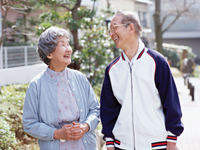 JAPAN'S DEMOGRAPHIC PROBLEM CAN be described as long-term bad news, intermediate-term good news. It took Japan only 24 years to see the ratio of people over 65 in the overall population double from 7 to 14 percent, while it is estimated that it will take 71 years to 2013 for the same to happen in the US. Based on current demographic trends, Japan's population will peak in 2006. One in four citizens will be 65 or older in Japan by 2020, according to a government estimate. By 2050, one-third of the population will be above retirement age, and the overall population (not accounting for immigration) will drop by 27 million people.
JAPAN'S DEMOGRAPHIC PROBLEM CAN be described as long-term bad news, intermediate-term good news. It took Japan only 24 years to see the ratio of people over 65 in the overall population double from 7 to 14 percent, while it is estimated that it will take 71 years to 2013 for the same to happen in the US. Based on current demographic trends, Japan's population will peak in 2006. One in four citizens will be 65 or older in Japan by 2020, according to a government estimate. By 2050, one-third of the population will be above retirement age, and the overall population (not accounting for immigration) will drop by 27 million people.
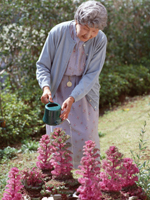 For the 60s crowd, the percentage of households that own their own home was 83.4, compared to 67 percent for those in their 40s and to 37 percent for those in their 30s. Those in their 60s were fortunate in that when they were in the prime of their working careers, Japanese wages continued to rise while housing prices were still reasonable. While property prices have plunged almost 80 percent from their peak, the deepest plunge has been in metropolitan area commercial property, and the 60s crowd still has significant unrealized property gains on their residences, in spite of the collapse of property prices.
For the 60s crowd, the percentage of households that own their own home was 83.4, compared to 67 percent for those in their 40s and to 37 percent for those in their 30s. Those in their 60s were fortunate in that when they were in the prime of their working careers, Japanese wages continued to rise while housing prices were still reasonable. While property prices have plunged almost 80 percent from their peak, the deepest plunge has been in metropolitan area commercial property, and the 60s crowd still has significant unrealized property gains on their residences, in spite of the collapse of property prices.
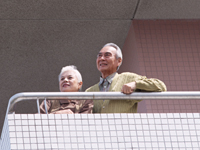 "Reverse mortgages" could give Gray Panthers a boost
"Reverse mortgages" could give Gray Panthers a boost
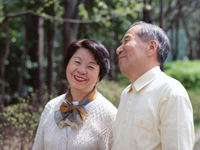 The Gray Panthers in action
The Gray Panthers in action
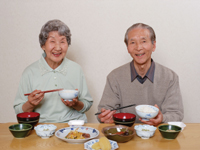 Restaurant home delivery, cleaning and shopping services
Restaurant home delivery, cleaning and shopping services
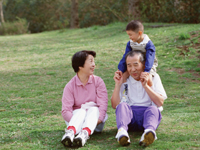 A survey conducted by the Japan Automobile Manufacturers Association (JAMA) revealed that the proportion of motorbike riders in their 50s or older is rising steadily from 25 percent in 1995. As young people desert the motorbike market, the pace set by seniors is helping to support two-wheeler sales.
A survey conducted by the Japan Automobile Manufacturers Association (JAMA) revealed that the proportion of motorbike riders in their 50s or older is rising steadily from 25 percent in 1995. As young people desert the motorbike market, the pace set by seniors is helping to support two-wheeler sales.



